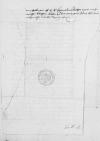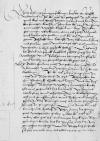Dem durchlauchten, hochgebornen fursten und herren, herren ⌊Albrechten⌋, von Gots gnaden marggraff zu ⌊Brandenburg⌋, in ⌊Preussen⌋, zu ⌊Stettin⌋, ⌊Pommern⌋, der ⌊Cassuben⌋ und ⌊Wenden⌋ hertzogk, burggraff zu ⌊Normberg⌋ und furst zu ⌊Rugenn⌋, / unnserm hochgunstigen, liebenn herren unnd freunde
Ewer Furstlichen Durchlaucht ⌊⌋, den VII dits monats an den hochwirdigen unsern freuntlichen lieben bruder, / den herren ⌊colmischen bischoff⌋ und uns / von ⌊Konigsperg⌋ ausgangen, / hab wir gestriges tages entpfangen, / doraus vornommen / Ewer / Furstliche / Durchlaucht / gneigten willen, / das es derselbten nicht were zuwidder gewese, / so wir iren brieff an die herren ⌊konigliche rethe⌋ gestelt, / ufgethan negst zum ⌊Elbing⌋ und vorlesen hetten, / do bei unser bedencken / was die teurung, die fast eindringt, / und andere hendel betrifft Ewer Furstlichen Durchlaucht angezeigt. / Dieweil uns aber under uns beiden solche wichtige sachen anzwnemen ane der andern herren woiwoden, castellanen etc. und der vornembsten zweier stedt beiwesen nicht hat wolt gezimen, / derhalben auch konigliche botschafft bis uf zukunftigen landtstag dis orts vorlegt, ist unser freuntliche bitt, / Ewer Furstliche Durchlaucht wolde des herren ⌊colmischen bischoffs⌋ und unser entschuldigung / mit gunst erwegen, / und wie auch Ewer Furstliche Durchlaucht schreiben meldet, / von wegen solcher notlichen ursachen freuntlich zulassen. / Es sol in kunfftiger ⌊tagefart⌋, / die uns ⌊konigliche maiestet⌋, unser aller gnedigister herr, / wirt seczen, / so wir in gotlichen gnaden mit gesundtheit dorzu kommen, / nichts nachbleiben, / dorÿnne wir Ewer Furstliche Durchlaucht ( der gunst wir uns bevelhen ) wilferig und so vil uns ummer muglich zu wolgefallen freuntlich dienen mugen.
2
Wie wir wolten diesen brieff besiegeln, / ist ⌊koniglicher maiestet⌋ kemerer / mit brieffen und dem ⌊Golinski⌋, / dem nicht ane ursach Ewer Furstliche Durchlaucht in ⌊yrem lande⌋ das sein zuvorkeuffen gebotten, / an uns kommen, / in welchen wir werden angehalten und gebetten, / das wir sein, / des Golinski, sache / Ewer Furstlichen Durchlaucht solten bevelhen, / wie dan aus beigelegten des hochwirdigen herren under cantzlers, / den wir bitten widder an uns wolde lassen kommen, zuvornehmen. / Wir bitten, wie wir gebetten, Ewer Furstliche Durchlaucht wolte die leczste condicion, / das ⌊Golinski⌋ sein zalunge zu einer zeitt volkommen wurde, / nicht aus schlahen, / mit dem wir, / was sonst von notten, weiter wollen schreybenn. /
3
Ewer Furstlichen Durchlaucht brieff an den hochwirdigen ⌊herren zu Culmesehe⌋ und uns semptlich geschrieben wolle wir seine lieb zuschicken. / Wirt Ewer Furstliche Durchlaucht mit gleichmessigem antwort, wie wir uns vorsehen, / zubesuchen nicht underlassen /
Newe zeÿtunge sein uns zukomen, / das der her ⌊Lasski⌋ widerumb an ⌊romische konigliche maiestet⌋ ist gelanget, / ir maiestet vier, unnd ⌊kayserlicher maiestet⌋ sechs jar ein anstand mit dem ⌊Turken⌋ zuwegen brocht. / Item das ⌊konigliche wird in Hungernn⌋ nicht weÿtter beÿfrid mit dem ⌊Turcken⌋ hot mugen uberkomen, / dann uff solchs monat, / unnd das die derhalbenn mit ⌊koniglicher maiestet⌋ unnsers herren botschafft, dem ⌊Soboczki⌋, iren boten, ein monch, / mit grössen goben, / unnd wie gesagt wirt, / mit dem vorhalten tribut, / geschickt habe etc. Das auch der Turck ein starck trefflich schlos zwÿschen der ⌊Walacheÿ⌋ unnd ⌊Podolÿen⌋ an eÿm grossen fliesse unnd daruber ein gewaltige brucke gebawet etc.
Dÿe ⌊Tataren⌋ furdren auch ire goben / oder zinsser. / So in die nicht werden, / wollen sich zum ⌊Moskowiter⌋ begeben / etc. ⌊Romische konigliche maiestet⌋ sol zw ⌊Prage⌋ sein im wege ins ⌊Niderlant⌋. / Ir ⌊maiestet⌋ botschaffter, der herr Serotinski, Szabka / und Loxan / umb der breslawschen niderlage wÿllen sein noch zu ⌊Kraka⌋. / Es wirt gehandelt, das die strasse widerumb werde freÿ unnd uffgethan etc. Der ⌊krokosche woÿwod⌋ mit funffhundert unnd sÿben und dreÿssig pferden in klag rustungen noch tode seiner ⌊hawsfrawen⌋ ist noch in ⌊Hungern⌋ etc.
Die ⌊junge konigliche maiestet⌋ braucht sich statlich in rethen, daran die ⌊herren⌋ gros wolgefallen haben. / ⌊Alte konigliche maiestet⌋ ist wider ( Got hab lob und ewigen danck ) zw solcher gesundtheit kommen, / das die von sich selbst in iren gemechern umbgeth. /
Der ⌊reichstag⌋ zu ⌊Kroka⌋ sol fast am ende sein. / Dis alles, wie es ahn uns komenn, / habe wir Ewer Furstlichen Durchlaucht freuntdinstlicher weis nicht mugen bergen. / Bitten, so die was gewissers het, uns auch nicht wolte verhalten etc. /









